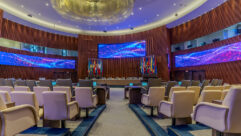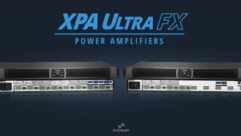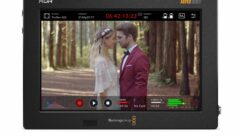
NewSoft WMS 200
Jan 1, 2008 12:00 PM,
By Jeff Sauer
Wireless display adapter makes cutting the cord easy.

We’ve all watched presenters juggling laptops and cables, and we’ve seen the flickering on the projection screen that says something is not quite right. We’ve also watched the inevitable mental struggle to remember what keystroke enables the monitor output. And we’ve all heard about wireless solutions that would cut that cord and make things easier. The NewSoft WMS 200 is a wireless interface that could make that cable fumbling a thing of the past.
Over the last few years, several projector manufacturers have experimented with building proprietary wireless interfaces into their displays in order to enable communication between a computer and the display device without using cables. Wireless companies such as Amimon, Avocent, and TZero offer transmitter-receiver device pairs that physically connect to the computer and the display on each end and share data through the air between them.
Comparatively, NewSoft’s solution is surprisingly simple and ultimately more flexible — and it’s a lot less expensive. Even better for professional AV administrators and event planners, it could have broad appeal on corporate and educational campuses and for panel discussions as an alternative to cable fumbling.
The WMS 200 is a single device that’s just slightly smaller than a typical wireless router and contains a similar wireless antenna. Instead of a transmitter-receiver pair, the WMS 200 is only a receiver, leveraging the 802.11a/b/g network cards and capabilities that are now standard fare in many notebook computers as its transmitter. Connecting to the WMS 200 wirelessly is as simple as searching for and connecting to the WMS 200’s wireless network (i.e., finding it in the list of available wireless networks), just as you would log on to any third-party network while traveling.
A small software application installed on the wireless computer (or running from an attached USB drive, but more on that in a moment) processes the screen information and hands it off to the wireless card to send to the WMS 200. In many ways, that software-enabled approach is similar to the aforementioned projectors that have built-in wireless connectivity. However, instead of having the wireless functionality built directly into the projector, the freestanding WMS 200 is connected directly to the display by either an analog 15-pin RGB cable or HDMI.
TWO MODES IN ONE DEVICE
Yet, there are other noteworthy differences beyond the ability to connect to more than just one brand of projector. Most other wireless solutions, particularly those built into presentation-oriented projectors, tend to focus on optimizing image quality for computer desktop images such as presentation slides, mouse movements, and other desktop activity where very little of the screen changes at any one time. Other solutions (such as the wireless HDMI solutions from Amimon and TZero) focus exclusively on motion video, rather than on the fine details of text and numbers. The WMS 200 does both.
In order to transmit visual images wirelessly, screen data has to be converted to digital data. Awkwardly, whether it’s a static computer desktop or motion video, it’s a lot of data, and it demands some prioritization to ensure responsiveness and image quality. Yet, computer desktop information — which tends to be fairly static, except for small mouse movements, keystrokes, and occasional window changes — needs to be crisp and easy to read even if it takes a few extra fractions of a second. Alternatively, with video, any delay causes unacceptable dropped frames.
The WMS 200 avoids the problem of choosing one mode or the other by including two optional modes: one for computer desktop and presentation images and a second for transmitting motion-video files. Actually, it’s even simpler than that. The WMS 200 software doesn’t even try to optimize any recompression for video. It simply allows you to browse your hard drive for video files, and then it just sends the native video file (MPEG-1, MPEG-2, MPEG-4, or WM9) to the WMS 200 device. A built-in video-decoder chip hands the video to the display with no recompression. Sure, that excludes videos that are embedded within presentation slides, but that is a good trade-off in the interest of video image quality, cost, and wireless bandwidth efficiency.
The WMS 200 does need to perform some modest compression to send computer desktop images, but you’ll be hard-pressed to see it. A lot of that compression is simple redundancy encoding and modest vector quantization. What’s even more impressive is the responsiveness that the new version of the software is able to achieve. If you’ve ever seen any of the built-in wireless projector solutions, or the older NewSoft WMS 100 for that matter, you probably have noticed a latency of between 1/2 second to 2 seconds when moving your cursor around the screen and perhaps even longer when advancing presentation slides. Those visible delays are, remarkably, all but gone with the WMS 200. The cursor moves with your hand, and the slides advance on-screen within a 1/4 of a second. Indeed, the only way I could really cause visible stuttering was by dragging entire windows back and forth across the screen.
ONE SMALL APPLET
Admittedly, the need to install an application locally in order to use the WMS 200 could be a major usage barrier. It’s awkward, particularly for a visiting presenter, and somehow just plugging in a cable seems safer and easier. However, the WMS 200 software utility is very simple to use and, better yet, it’s very small.
Beyond the humble configuration tools, the only visible parts of the software are the simple play, pause, stop, and browse-for-video controls. There’s more going on behind the scenes in order to hand the screen-image data off to the wireless card, of course, but nothing that makes the application big. Therefore, an SE version of the software (lacking the video browse-and-playback function) doesn’t even have to be installed; it can instead run off a USB thumb drive.
Imagine then a panel discussion in which a series of presenters pass around a couple of thumb drives (instead of that monitor cable), connect to the WMS 200 wireless network with a mouse click, and are ready to go when they are announced, instead of fumbling with the cable. Or imagine a company executive being able to walk into any boardroom (equipped with a WMS 200), open a laptop, and present with no hassle. It would make both the executive and the AV staff look pretty sharp. Smartly, NewSoft offers USB drives for $29, with potential volume discounts and larger-scale site licenses to go along with the WMS 200.
Cutting the cord to the projector isn’t new, but it’s probably never been so easy. What’s more, it’s never been so easy to do it on a broad scale across a campus or for a panel discussion.
PRODUCT SUMMARY
Company: NewSoft www.newsoftinc.com
Product: WMS 200
Pros: Low price, very low latency, separate mode for video playback, presentation mode can run off USB drive.
Cons: Full version requires software install.
Price: $349
SPECIFICATIONS
OS: Windows 2000/XP
System requirements: Intel Pentium III, 800MHz, 256MB RAM
Video output: 15-pin D-Sub, HDMI
Video file playback: MPEG-1, MPEG-2, MPEG-4, WM9
Wireless LAN: 54Mbps 802.11a/b/g
Processor: SigmaDesigns 8622 decoder, 166MHz ARM 7
Flash memory: 8MB
Graphic resolution output: 800×600, 1024×768 (1280×1024 at reduced frame rates)
Color depth: 16-/24-/32-bit
Warranty: One year parts and labor










